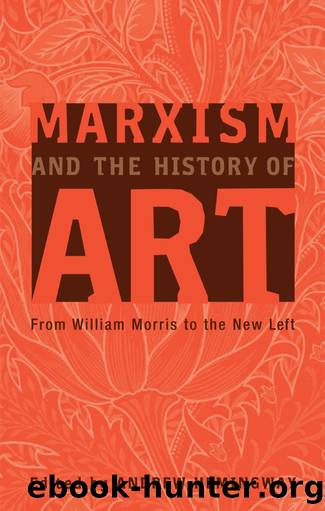Marxism and the History of Art by Hemingway Andrew

Author:Hemingway, Andrew.
Language: eng
Format: epub
Publisher: Book Network Int'l Limited trading as NBN International (NBNi)
FROM CRITIQUE TO CONTRIBUTION
With his work on aesthetic theory, Lefebvre attempted to bring philosophical considerations to bear on the reductive version of dialectical materialism that was common with party officials and subordinate intellectuals in the post-war period. Lefebvreâs Contribution à lâesthétique was written at the same time as the Critique de la vie quotidienne and also in the same period as Mikhail Lifshitsâs influential 500-page publication on Marxist aesthetics, MarxâEngels über Kunst und Literatur (1949). Lefebvre developed his most significant contribution to Marxist thinking, the materialist conception of everyday life, at the same time as his more popular writings on art and literature. The Contribution and the Critique should therefore be thought of as related but not analogous texts.
In The Critique of Everyday Life, Lefebvre outlined not only a critical theory of capitalist society, but also a number of important reflections on the art of the twentieth century which cannot be found in the Contribution. Perhaps most controversial is his polemic against Surrealist practice, which he criticised for repudiating everyday life and humanity itself rather than transforming the world. In a reference to Marxâs critique of Eugène Sueâs novels, Lefebvre stated that the Surrealists âpromised a new world, but they merely delivered âmysteries of Parisââ.20 He contrasted this with Brechtâs work, which went beyond transparency and attempted a more serious project of clarifying contradictions and struggling against alienation. Lefebvreâs innovation with the Critique was to argue that the everyday was not necessarily known. Although conceptions of the everyday can be found in the work of Nietzsche, Simmel, the Surrealists, Lukács and Heidegger, Lefebvre sought to align the everyday with the notion of alienation rather than the banal or the trivial. The everyday in this sense becomes dialectically bound up with the potential for disalienation, for an opening onto new possibilities. Lefebvre wished to elevate the category of the lived or the concrete to a theoretical level without at the same time overestimating it, as phenomenology had done.21 As early as the mid-1930s, Lefebvre explored the reasons why the working class was not conscious of the mechanisms of its own exploitation. In La Conscience mystifiée (1936), as well Le Matérialisme dialectique (1939), he developed the theme of alienation, which alone could explain capitalist social relations and which drew from Marxâs early philosophical works. In rejecting the Surrealistsâ poetic solutions to alienation, Lefebvre attempted to develop some theoretical tools for a new approach to art theory and production.22 While his work on aesthetics coincided with the PCFâs adoption of Zhdanovist reductionism, he nevertheless sought to engage with the debates on Socialist Realism, which he distinguished himself from by using the term ânew realismâ. In the pages below, I focus on a number of key aspects of the Contribution and follow this with some remarks on Lukács. The Critique, nevertheless, remains an important double in the writing of Lefebvreâs aesthetic theory.
Addressing the notion of the specificity of art, Lefebvre cautiously considers artâs connection with knowledge. The theory of knowledge, he argues, is merely logical and abstract if it does not engage with living thought and with the concrete world.
Download
This site does not store any files on its server. We only index and link to content provided by other sites. Please contact the content providers to delete copyright contents if any and email us, we'll remove relevant links or contents immediately.
Papillon by Henry Charrière(807)
Watercolor With Me in the Forest by Dana Fox(594)
The Story of the Scrolls by The Story of the Scrolls; the M(561)
This Is Modern Art by Kevin Coval(465)
A Theory of Narrative Drawing by Simon Grennan(461)
Frida Kahlo by Frida Kahlo & Hayden Herrera(451)
Boris Johnson by Tom Bower(447)
Banksy by Will Ellsworth-Jones(438)
AP Art History by John B. Nici(433)
The Art and Science of Drawing by Brent Eviston(433)
Van Gogh by Gregory White Smith(430)
Glittering Images: A Journey Through Art From Egypt to Star Wars by Camille Paglia(427)
Draw More Furries by Jared Hodges(425)
War Paint by Woodhead Lindy(418)
Scenes From a Revolution by Mark Harris(416)
100 Greatest Country Artists by Hal Leonard Corp(395)
Ecstasy by Eisner.;(394)
Young Rembrandt: A Biography by Onno Blom(376)
Theater by Rene Girard(360)
